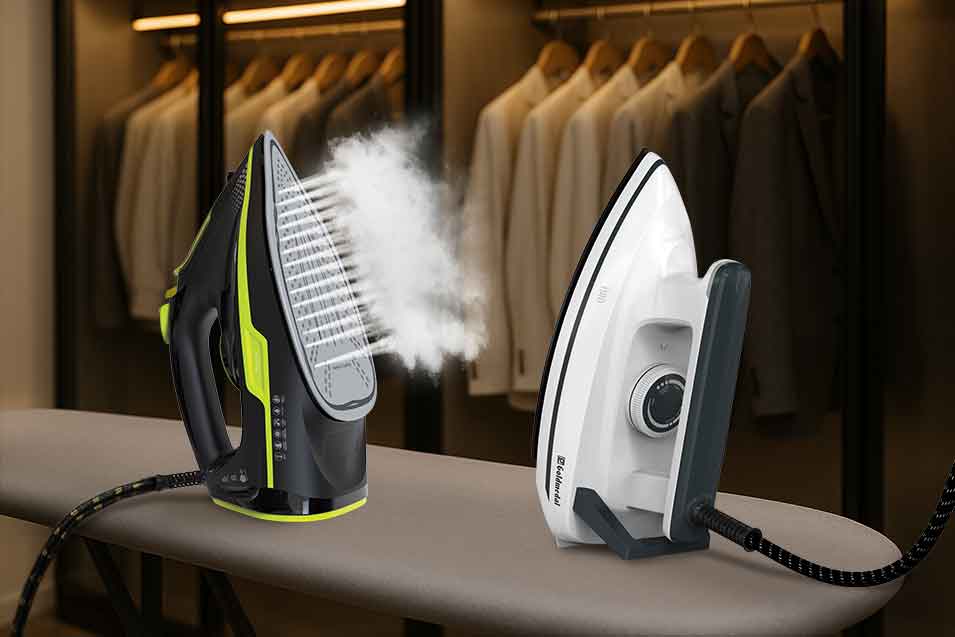
2 Types of Iron for Clothes: Which One Suits Your Needs?
22nd September 2025 | Written By: Vinod Pottayil | Read Time: 3min | Last Updated: 22nd September 2025
When you need a wrinkle-free finish to your clothes, an iron comes to your rescue. But, wait. Which one should you use – a dry iron or a steam iron? The right choice will not only make your clothes appear clean and crisp, but also take care of the fabric. Let’s explore the differences and benefits of both types of iron.
What is Dry Iron?
A dry iron is the conventional iron which comes with a non-perforated soleplate. When you switch on the iron, the soleplate gets heated. You manually spray the water on the clothes and glide the dry iron to smooth the wrinkles.
What is a Steam Iron?
A steam iron has a perforated metal soleplate and an in-built water tank. When you turn on the iron, it heats the water inside the tank to generate steam through the holes of the soleplate. You can then press the clothes to remove the creases.
Comparison: Dry Iron vs Steam Iron
-
Fabrics:
Dry iron is suitable for delicate or moisture-sensitive fabrics such as silk, satin, chiffon and wool.
A steam iron is recommended for denims, linens, cottons or thick materials with deep wrinkles. They are good for fabrics that need additional moisture for ironing.
-
Compactness and Portability:
Dry iron has a compact, lightweight and travel-friendly design.
A steam iron is a little bulkier than a dry iron due integrated water reservoir for steam release.
-
Maintenance:
Dry iron is low-maintenance due to a non-perforated soleplate and the absence of a water tank. There is no risk of water leakage or mineral build-up, resulting in clogging.
A steam iron needs regular maintenance, like cleaning of mineral build-up.
-
Performance Effectiveness:
Dry iron is less effective for ironing outfits made from thick materials or with stubborn creases. It would be challenging to ease out rumples despite putting extra manual pressure. It may need multiple attempts to get the desired wrinkle-free look.
The steam iron effortlessly removes deep wrinkles owing to its dual mechanism of heat and water generation. The overall finish is better and smoother than the dry iron.
-
Cost-Effectiveness:
Dry iron is more affordable than a steam iron due to the difference in design and functionality. However, a steam iron is more cost-effective for sturdy and thicker fabrics.
-
Ease of Usage:
Dry iron has a plug-and-play, no-fuss operation.
If you are doing a bulk load, you may need to refill the water tank in the steam iron.
A steam iron has different temperature settings and their adjustment may take up a little time. However, these settings make them more versatile and customisable for the desired finish. It is also appropriate for vertical ironing. Moreover, a steam iron can double up as a dry iron by turning off its steam function.
-
Power Consumption:
A steam iron consumes more electricity as it needs energy for water heating and conversion into steam. It takes up a few minutes before it is ready for use. Hence, it also has a higher wattage.
On the contrary, dry iron requires less power due to which saves on energy and electricity bills.
Dry iron needs minimum power at 600W-1200W as compared to a steam iron at 1200W-2200W. The right temperature settings can make energy consumption more effective.
Which Iron is More Suitable?
Both dry iron and steam iron have their merits and demerits. Hence, the suitability depends on your personal requirements and preferences, the fabrics you want to iron at home and your budget. Irrespective of your choice, make sure you buy the iron from a reputable and trustworthy home appliances brand.

Frequently Asked Questions (FAQs) :
- Q1. What is the main difference between a dry iron and a steam iron? Dry iron needs manual sprinkling of water to remove wrinkles. A steam iron has an in-built water tank that generates steam and vents out through holes in the soleplate for ironing.
- Q2. Which type of iron is good for jeans, linen, bedsheets, etc? These are thicker fabrics with deep and stubborn folds. Hence, a steam iron is a good option.
- Q3. Which type of iron should be used for delicate fabrics? Delicate fabrics such as silk, satin or wool are prone to water damage. Hence, dry iron is recommended.
- Q4. Which is easy to use? Dry iron is easy to use due to its simple plug-and-play design and minimal maintenance. While a steam iron has different settings for operation, it brings versatility and customised ironing for easy use.
- Q5. Can a steam iron be used without water? Yes. A few models of steam irons have a ‘dry mode’ that allows you to use them without filling the water tank.




